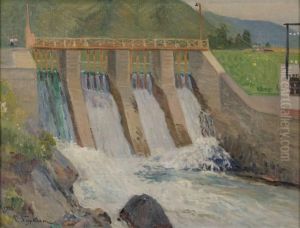Grigori Ivanovith Gurkin Paintings
Grigori Ivanovitch Gurkin was a prominent Russian and later Soviet painter, known for his significant contributions to the art world, particularly in the realm of landscape painting. Born on February 19, 1870, in the village of Terekhino, now part of the Altai Krai in Siberia, Gurkin grew up in a time of great change in Russia, witnessing the transition from the Tsarist regime to the Soviet Union. His early life in the picturesque landscapes of the Altai mountains deeply influenced his artistic direction, imbuing his works with a profound sense of place and the natural beauty of Siberia.
Gurkin's educational journey in art began in earnest when he moved to Saint Petersburg, the cultural capital of Russia, to study. His talent and dedication to capturing the essence of the Russian landscape quickly became evident. Despite the challenges of his time, including financial difficulties and the political upheavals of the early 20th century, Gurkin's passion for art remained unwavering. He was particularly adept at integrating the realism of Russian landscape painting with the emerging styles of the early Soviet period, making his work stand out among his contemporaries.
Over his career, Gurkin became deeply involved in the artistic life of Siberia, contributing to the development of a distinctly Siberian school of painting. His works often depicted the vastness of the Siberian landscapes, the daily life of its people, and the dramatic changes the region underwent during his lifetime. Gurkin's art was not just a reflection of the physical landscapes but also an exploration of the spiritual and cultural identity of Siberia. He is credited with helping to establish the Altai region as a significant cultural and artistic center in Russia.
Gurkin faced numerous challenges throughout his career, including periods of political suspicion and scrutiny, particularly during the Stalinist era. Despite these difficulties, he continued to work and create, leaving behind a legacy of profound artistic achievement. Grigori Ivanovitch Gurkin passed away on August 7, 1937, in Gorno-Altaysk, capital of the Altai Republic. Today, his works are celebrated for their historical and cultural significance, providing insight into the life and landscape of Siberia during a period of great change. Gurkin remains a pivotal figure in Russian and Siberian art, honored for his dedication to capturing the essence of his homeland.
